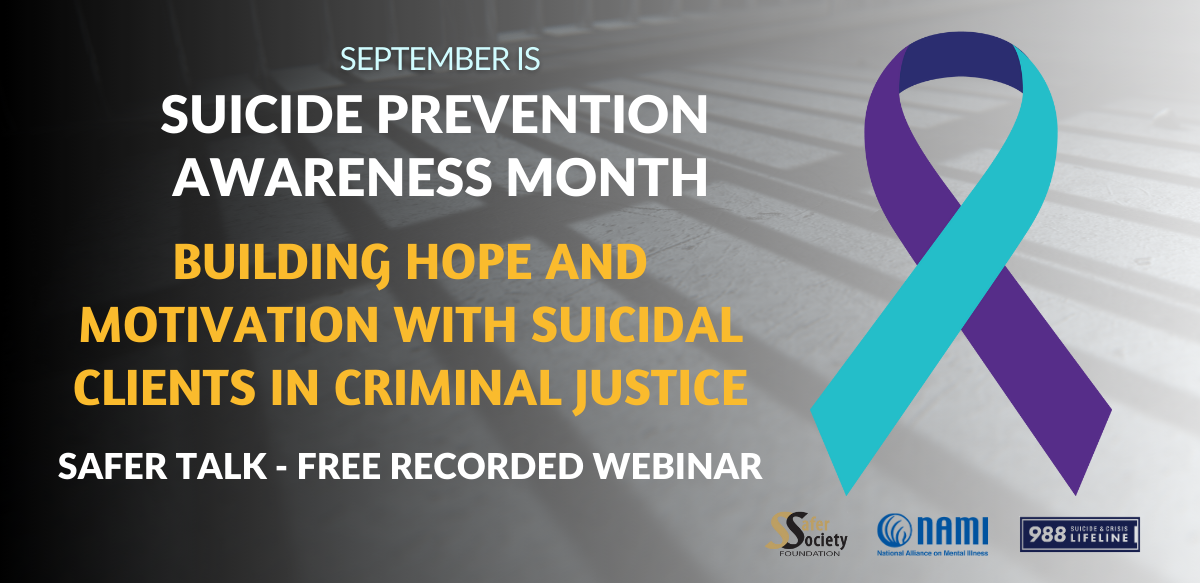
There is perhaps no more critical time for helping professionals to listen to a client than when they talk about suicide. As a professional, you want to steer the client in a different direction. But is that the best approach? During the Safer Talk webinar Building Hope and Motivation with Suicidal Clients in Criminal Justice, guest speaker Natalie Cyr suggests that perhaps the best way to help those talking about suicide is to listen to their pain and offer to accompany them toward safety.
What does it mean to “accompany them”? This is where Cyr combines her 20 years of experience as a probation officer and trainer in Motivational Interviewing to help us better understand what we can and cannot do for those considering suicide – especially those involved in the criminal justice system.
“…people with mental illness are overrepresented in our nation’s jails and prisons. About two in five people who are incarcerated have a history of mental illness (37% in state and federal prisons and 44% held in local jails). This is twice the prevalence of mental illness within the overall adult population….America’s jails and prisons have become de-facto mental health providers..” – The National Alliance on Mental Health
Listening for Ambivalence
Those who are considering suicide need a safe space to tell their story and fully express their loss. This is especially true for those who are involved in the criminal justice system who have, in addition to their personal losses, lost many freedoms. Listening and acknowledging the person’s desire to die are powerful ways to help.
But in this webinar, Cyr and host David Prescott tell us we can do more: we can listen for signs of uncertainty and ambivalence. After all, at the very least, the person has chosen to live today. What exists in their lives that makes them chose to live? Is it a person they love? An activity that brings them fulfillment? Reminding clients of the choices they made to live today creates momentum toward the part of them that wants to continue living.
“It’s about keeping that person safe—for now. And then, in their safety plan, you connect them with the resources and people that will connect them with life. Resources that will enhance their connection with life.” – Natalie Cyr
Creating Long-Lasting Momentum for Change
Nathalie Cyr uses Motivational Interviewing techniques to generate long-lasting momentum. She shows us how to listen to clients to help recognize their ambivalence and how to help connect them with reasons they may have to change. All four of the key processes of Motivational Interviewing are brought to bear when working with clients considering suicide:
- Engagement: Any chance for change relies on keeping the client constantly engaged in a discussion with the therapist. Cyr refers to this as the “relational foundation”—a component of the interaction that must always happen.
- Focus: This motivational interviewing technique recognizes that clients often have multiple issues needing to be addressed, and once engaged, the therapist and client need to agree on the key goal of their interaction. With suicidal clients, the focus lies on the client’s expressed wish to commit suicide.
- Evoking: Evoking means to “bring out,” which involves questioning, summarizing, reflecting, and affirming the client’s point of view. These core skills of an experienced therapist are crucial at this time. The therapist is also listening for the ambivalence: the part of the client that wants things to stay the way they are now and the part that wants to change.
- Planning: When the client acknowledges the ambivalence and is now more tightly linked to what connects them with life, the goal is to develop a safety plan—steps the client can take when they feel at risk. Steps that will take them back to the people or the activities that connect them with life.
These skills correspond with the skills offered during the ASIST (Applied Suicide Intervention Skills Training) program. The safety plan spells out how the client can connect with resources in their community that will help them during times of crisis and empower them to take an active role in their own safety.
In Cyr’s words,
“The job of the caregiver is to provide the space to hear their story and to look for their turning point. And their turning point is the other part of the ambivalence. That may be a connection with life, maybe with hope. It will form the change talk that will help us move on and create the safety plan.”
We invite you to listen to this enlightening hour-long webinar conversation, Building Hope and Motivation with Suicidal Clients.
About Nathalie Cyr: for the past five years, Nathalie Cyr has been a Senior Training Consultant and Motivational Interviewing Trainer for the Department of Justice and Public Safety in the Province of New Brunswick, Canada. Prior to that, she served as a Probation Officer for 20 years. Ms. Cyr is a member of the Motivational Interviewing Network of Trainers, a Master Trainer for Livingworks’ Applied Suicide Intervention Skills Training (ASIST), and a Trainer for users of the Level of Service Assessment (LS-CMI and YLS-CMI.


